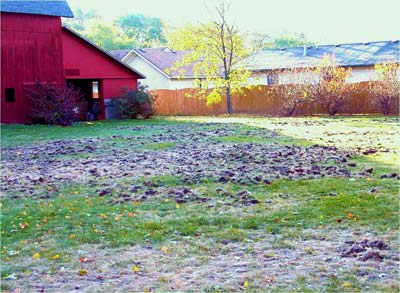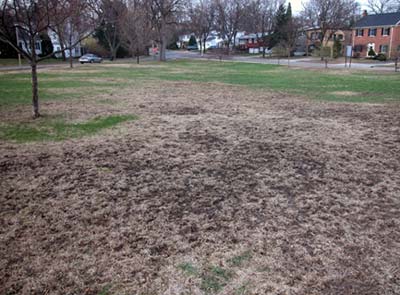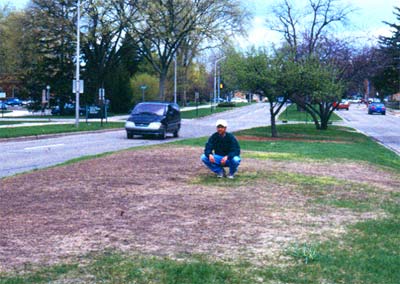Dead patches in lawns or golf course roughs may be from grubs
Watch for dead patches in lawns that grow larger over the next three weeks. Learn how to prevent grub and skunk problems in the future.
European chafer and Japanese beetle grubs are feeding heavily on turf roots now in southern Michigan. When most of the roots are consumed, you may see patches of thin or dead turf or even bare soil. The dead patches may grow larger each week from now until mid-May. The problem becomes worse when skunks or raccoons find the grubs and tear up the poorly anchored turf for an easy meal.

Fall grub and skunk damage in DeWitt, Mich.

Spring grub damage in East Lansing, Mich.
If you suspect a grub problem in your lawn, dig-up a few squares of turf around the edges of the damaged areas and look for C-shaped white grubs in the soil around the roots. If there are enough grubs to cause visible damage to your lawn, you won’t have any trouble finding them.
Infested areas of lawns can be treated with Sevin (carbaryl) or Dylox (trichlorfon) now to slow down the grubs and damage from skunks and raccoons, but other turf insecticides will not work at this time. Another way to discourage skunks is to apply Milorganite, a fertilizer that the skunks find distasteful. For information on selecting the right products to prevent grub damage next year and the correct time to apply them, see the MSU Extension article "All about home lawn grub control products for 2013."

Spring grub damage on the MSU campus.
For most homeowners, grub damage can be prevented by raising the mowing height on your lawn mower to the highest setting (usually about 3.5 inches), fertilizing modestly and watering during dry periods. This promotes a much larger root system under your lawn, making it much more tolerant of feeding injury from hungry grubs. It may take a year or two to grow a dense lawn.
If you need protection from grubs during this time, you can apply an effective grub control product each year in July. See turf.msu.edu for more details.
Smart gardening tip sheet



 Print
Print Email
Email


